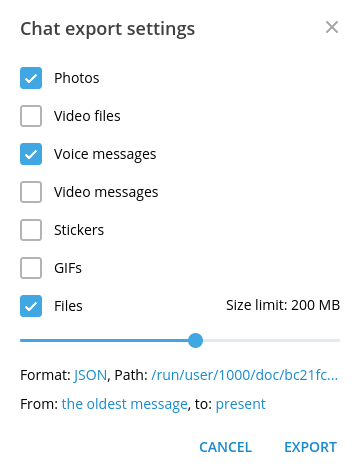Python script to convert Telegram chat export to Obsidian vault
This script parses output from Telegram channel or group and converts each post to a Markdown file.
Telegram Desktop creates JSON file, as well as different directories containing multimedia, photos, etc. This script creates new directory and populates it with formatted posts. As a result, the folder containing original media subfolders and this newly created formatted posts folder could be opened in Obsidian as a vault.
In Obsidian, all links between the channel/group posts are converted to wiki links, all photos and other media display embedded in pages like in Telegram.
Easy usage on Windows
For chat with alias
I.e. for chats where links to messages look like https://t.me/samuprav/342
- Put
tg2md.pyandtg2md-link_alias.batto the same folder whereresult.jsonand other exported stuff resides. - Edit
tg2md-link_alias.batand replace<chat_alias>with actual chat alias (likesamupravin the example above). - Run
tg2md-link_alias.bat.postssubfolder containing posts will be created by the script. - Check the result by opening the folder as vault in Obsidian.
- If the result is OK for you and links inside the vault work fine, delete
tg2md-link_alias.bat,tg2md.py, andresult.json.
For private chat or chat without alias
I.e. for chats where links to messages look like https://t.me/c/5345344532/342
- Put
tg2md.pyandtg2md.batto the same folder where result.json and other exported stuff resides. - Run
tg2md.py.postssubfolder containing posts will be created by the script. - Check the result by opening the folder as vault in Obsidian.
- If the result is OK for you and links inside the vault work fine, delete
tg2md-link_alias.bat,tg2md.py, andresult.json.
Basic usage
Firstly you need to export your channel history from Telegram Desktop app. This could be done from three dots menu. Then popup menu appears, where you can choose what data you want to export. The script currently supports only photos, voice messages and audio files.
In format menu you should specify 'Machine-readable JSON' file and then locate to directory of your desire.
To convert your posts to markdown files you need to run tg2md.py program
which takes path to your result.json file as first argument.
$ python tg2md.py path/to/result.jsonBy default it will create posts directory in your current directory
and populate it with markdown files. If you want to specify other location,
use --out-dir flag
$ python tg2md.py result.json --out-dir path/to/post/outputFor correct linking of posts, please specify channel alias ('@name' without @)
using the --alias parameter. I.e. for https://t.me/samuprav:
$ python tg2md.py result.json --alias samupravYou can also customize names of directories for storing media files instead
of default photos and files by specifying them with --photo-dir and
--media-dir parameters respectively. Note that they only change links in the
markdown files. This actually does not make sense for Obsidian and will be removed.
Todo
- replies (prev post transcluded)
- wiki-links and external links
- links to original Telegram posts
- post author tag for groups
-
yyyy-mmsubfolders to output posts folder - forwarded posts
- single/muliple tags
- custom post header
